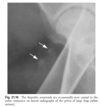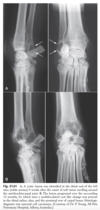21. Joint Disease Flashcards
(68 cards)
How does joint space thickness vary over time in the presence of joint disease?
- Typically:
EARLY: Expansion (effused)
LATE: Collapse (due to cartilage degradation)
=> Later phase rarely dx due to lack of weight bearing rx and variable projection angles
Radiographic features of JOINT DISEASE

Image with examples…

List three examples of large accumulations of articular or periarticular mineralisation?
1) Intraarticular OSTEOCHONDROMA
2) Meniscal mineralisation (cats)
3) “Pseudogout” - calcium pyrophosphate deposition disease (dogs)
List three distinct categories of articular calcified bodies?
1) Avulsed fragments -> articular or periarticular bone
2) Osteochondral components of disintegrating joint surface
3) Small synovial osteochondromas
Pathophys of osteophyte formation?
- Degradation of articular cartilage
- Degradation products -> synovial hyperplasia
- Synovial hyperplasia -> Osteophyte (initially cartilage, later ossified)
=> Bony outgrowths at periphery of articular cartilage
What are entheses?
- INSERTION of tendon, ligament, joint capsule, or fascia TO BONE
Enthesophyte = Bony spondylopathy at enthesis
Common entheses of carpus x 5

Main enthesis of shoulder x 3

Main entheses of stifle X 5

What is Vacuum phenomenon? What are the posible causes of intrarticular gas (4 broad categories)?
- Vacuum = Intrarticular diffusion of nitrogen from ECF following negative pressure

In what % of shoulder with humeral head OCD radiographs is vacuum phenomenon seen?
20%
NOT a feature in normal contralateral radiographs!
List 4 clinical conditions associated with intraarticular gas
- Osteochondrosis
- Degenerative IVDD
- Vertebral instability
- DJD

Sites of sesamoids in the dog TABLE


What % of feline menisci have mineralisation in stifle rads? Which site most commonly affected?
46%
Cranial horn, medial meniscus
=> % mineralisation significanly associated with degree of cartilage damage in medial femoral and tibial condyles. THEREFORE associated with medial compartment DJD

MCP sesamoid fragmentation is associated with which bones and which breeds?
2nd and 7th MCP sesamoids
ROTTIS (several large breeds)
=> up to 44% in one group of rottis; 73% in one group up to 12mo with CS associated in 65%
Another group: cause of FL lameness in 50% young rottis

Transverse fragmentation of the digital sesamoids reported in which breed?
Racing greyhounds -> possibly fracture is cause
What is the most common example of sesamoid displacement? Which breeds are predisposed?
Patella luxation!
Toy breeds and Devon Rex
What are these

Iliopubic sesamoids!

What are the three most frequent locations of canine DJD?
- Hips (dysplasia
- Shoulder
- Stifles
What is the incidence of shoulder and stifle DJD reported at rx / necropsy?
Shoulder: 33-50%
Stifle: 20%
What are the two sesomoids of the tarsus!! Odd….
Lateralplantar tarsometatarsal sesamoid
Intra-articular tarsometatarsal sesamoid

What is the most reliable feature to assess for grading of stifle DJD?
- Number and size of osteophytes
=> other features less reliable e.g. effusion, sclerosis, mineralisation
What is the timeline of onset of osteophytosis after cranial cruciate transection?
- Commence as early as 3 days -> margins of femoral trochlea seen radiographically at 2 weeks
Prox / dist fem trochlea -> femoral and tibial condyles and patella
Enthesophytes: CrCr and collateral
List 3 specific views that can be used to identify early trochlear osteophytes?
1) Flexed mediolateral
2) Craniomedial - caudolateral
3) Caudomedial - craniolateral





















